A Thematic Analysis Report on Reverse Logistics in Supply Chains
VerifiedAdded on 2023/06/10
|26
|4690
|474
Report
AI Summary
This report presents a thematic analysis of reverse logistics in supply chain management, focusing on sustainability, cost savings, and environmental impact. It reviews at least 15 academic articles, identifying major themes such as strategic applications for product reclamation, the role of recycling and reuse, and the importance of efficient reverse logistics design for environmental sustainability. The analysis also considers factors influencing reverse logistics implementation, including human resources, financial stability, and government regulations. The report highlights the need for companies to formulate efficient models and techniques to address challenges and leverage opportunities in reverse logistics, enhancing customer satisfaction and loyalty. Desklib offers a wealth of similar solved assignments and past papers for students seeking additional resources.
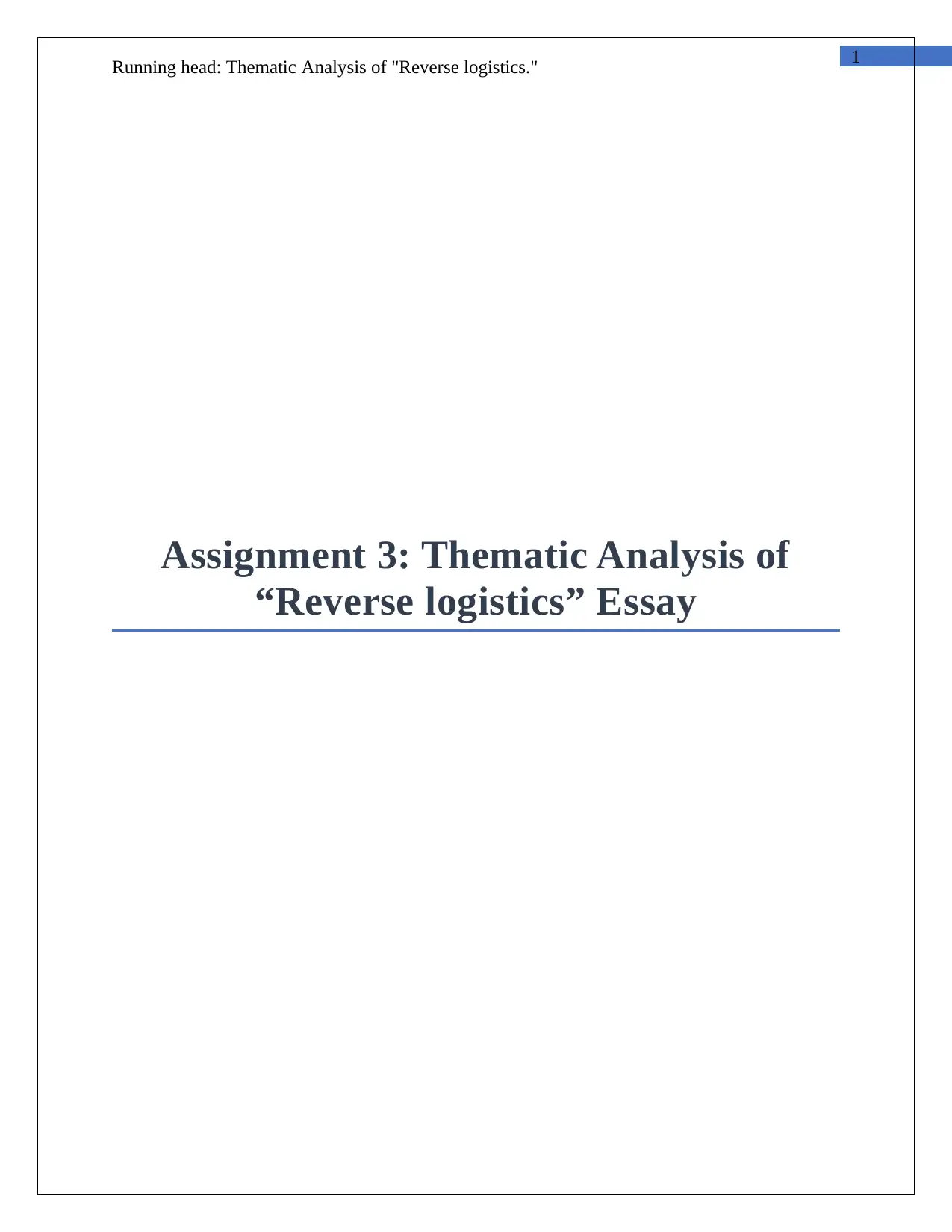
1
Running head: Thematic Analysis of "Reverse logistics."
Assignment 3: Thematic Analysis of
“Reverse logistics” Essay
Running head: Thematic Analysis of "Reverse logistics."
Assignment 3: Thematic Analysis of
“Reverse logistics” Essay
Paraphrase This Document
Need a fresh take? Get an instant paraphrase of this document with our AI Paraphraser
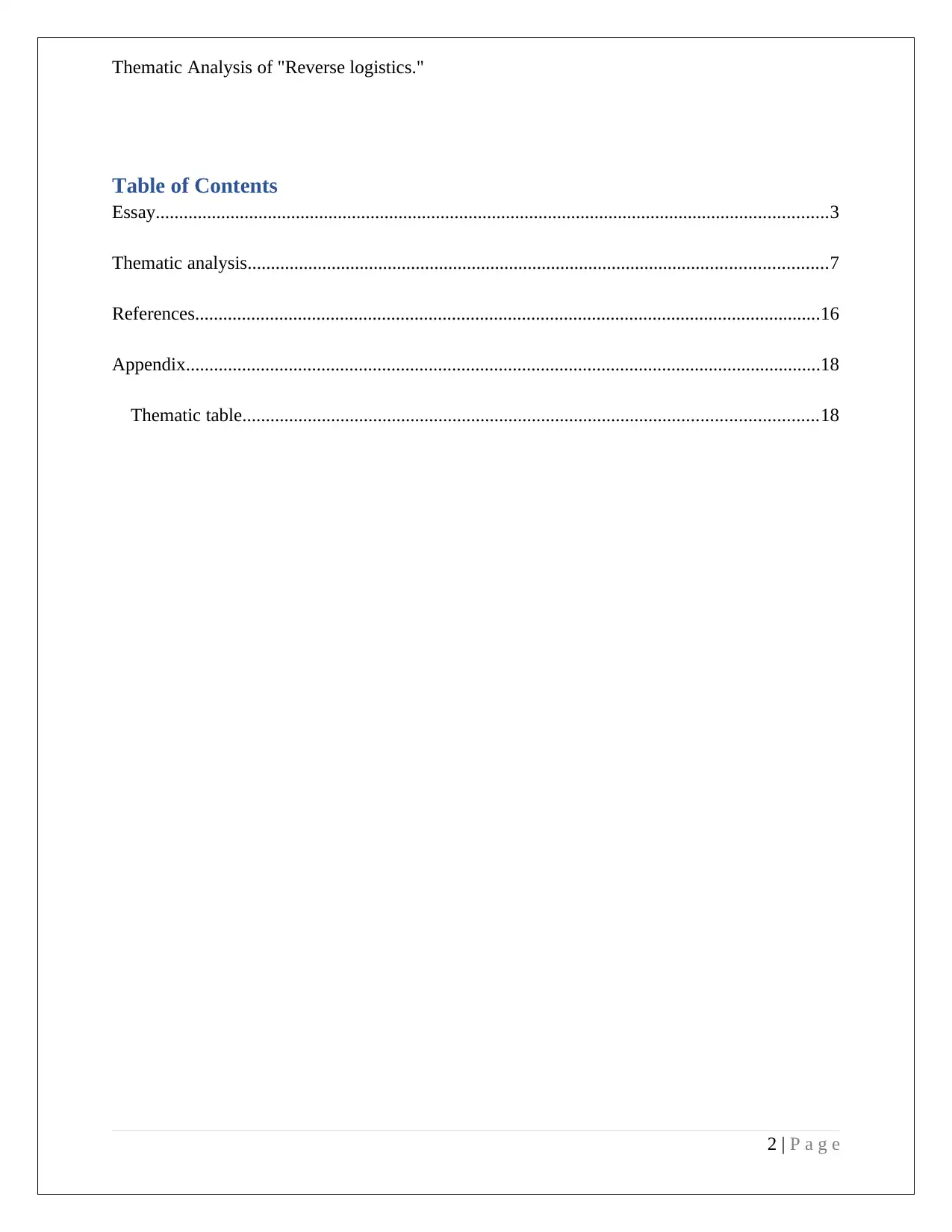
Thematic Analysis of "Reverse logistics."
Table of Contents
Essay................................................................................................................................................3
Thematic analysis............................................................................................................................7
References......................................................................................................................................16
Appendix........................................................................................................................................18
Thematic table...........................................................................................................................18
2 | P a g e
Table of Contents
Essay................................................................................................................................................3
Thematic analysis............................................................................................................................7
References......................................................................................................................................16
Appendix........................................................................................................................................18
Thematic table...........................................................................................................................18
2 | P a g e
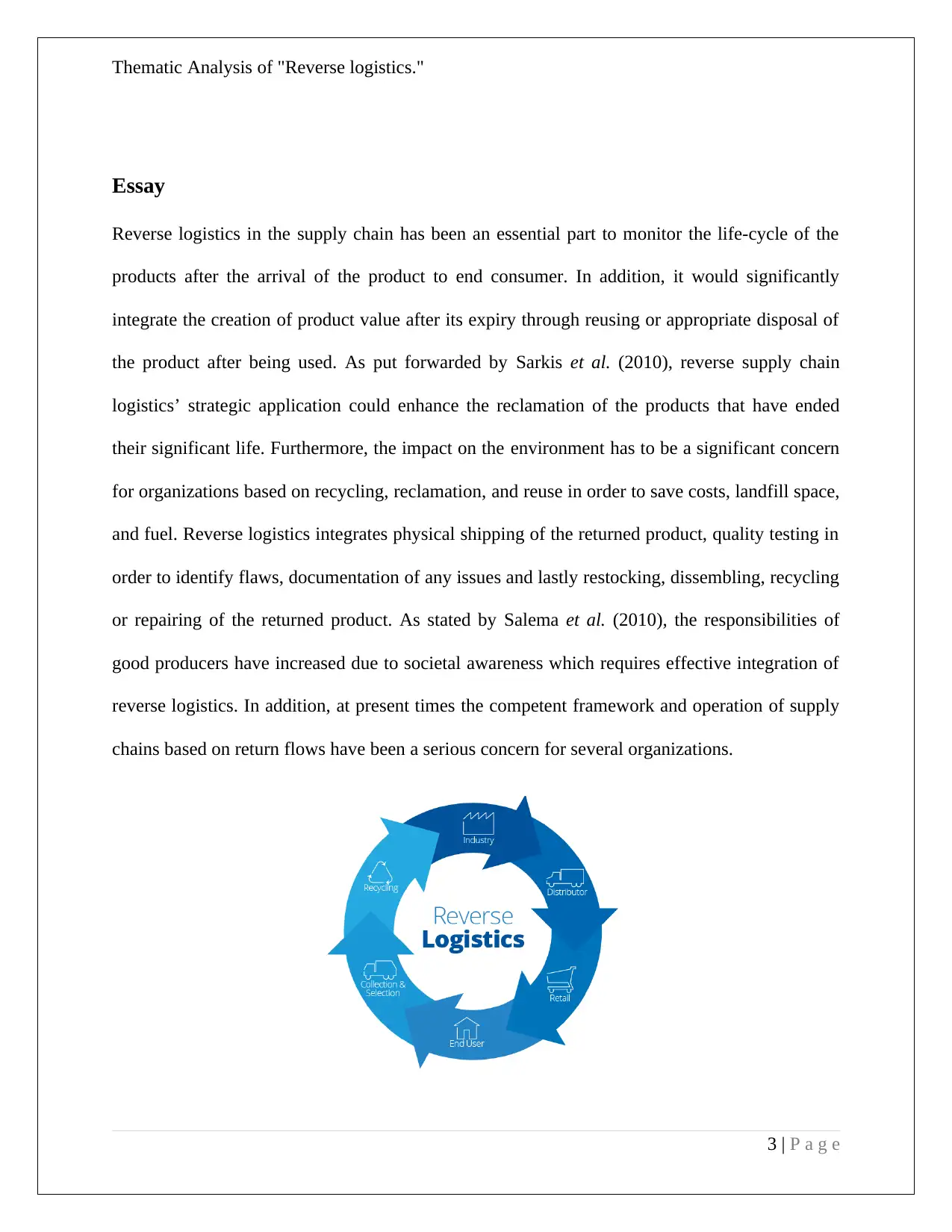
Thematic Analysis of "Reverse logistics."
Essay
Reverse logistics in the supply chain has been an essential part to monitor the life-cycle of the
products after the arrival of the product to end consumer. In addition, it would significantly
integrate the creation of product value after its expiry through reusing or appropriate disposal of
the product after being used. As put forwarded by Sarkis et al. (2010), reverse supply chain
logistics’ strategic application could enhance the reclamation of the products that have ended
their significant life. Furthermore, the impact on the environment has to be a significant concern
for organizations based on recycling, reclamation, and reuse in order to save costs, landfill space,
and fuel. Reverse logistics integrates physical shipping of the returned product, quality testing in
order to identify flaws, documentation of any issues and lastly restocking, dissembling, recycling
or repairing of the returned product. As stated by Salema et al. (2010), the responsibilities of
good producers have increased due to societal awareness which requires effective integration of
reverse logistics. In addition, at present times the competent framework and operation of supply
chains based on return flows have been a serious concern for several organizations.
3 | P a g e
Essay
Reverse logistics in the supply chain has been an essential part to monitor the life-cycle of the
products after the arrival of the product to end consumer. In addition, it would significantly
integrate the creation of product value after its expiry through reusing or appropriate disposal of
the product after being used. As put forwarded by Sarkis et al. (2010), reverse supply chain
logistics’ strategic application could enhance the reclamation of the products that have ended
their significant life. Furthermore, the impact on the environment has to be a significant concern
for organizations based on recycling, reclamation, and reuse in order to save costs, landfill space,
and fuel. Reverse logistics integrates physical shipping of the returned product, quality testing in
order to identify flaws, documentation of any issues and lastly restocking, dissembling, recycling
or repairing of the returned product. As stated by Salema et al. (2010), the responsibilities of
good producers have increased due to societal awareness which requires effective integration of
reverse logistics. In addition, at present times the competent framework and operation of supply
chains based on return flows have been a serious concern for several organizations.
3 | P a g e
⊘ This is a preview!⊘
Do you want full access?
Subscribe today to unlock all pages.

Trusted by 1+ million students worldwide
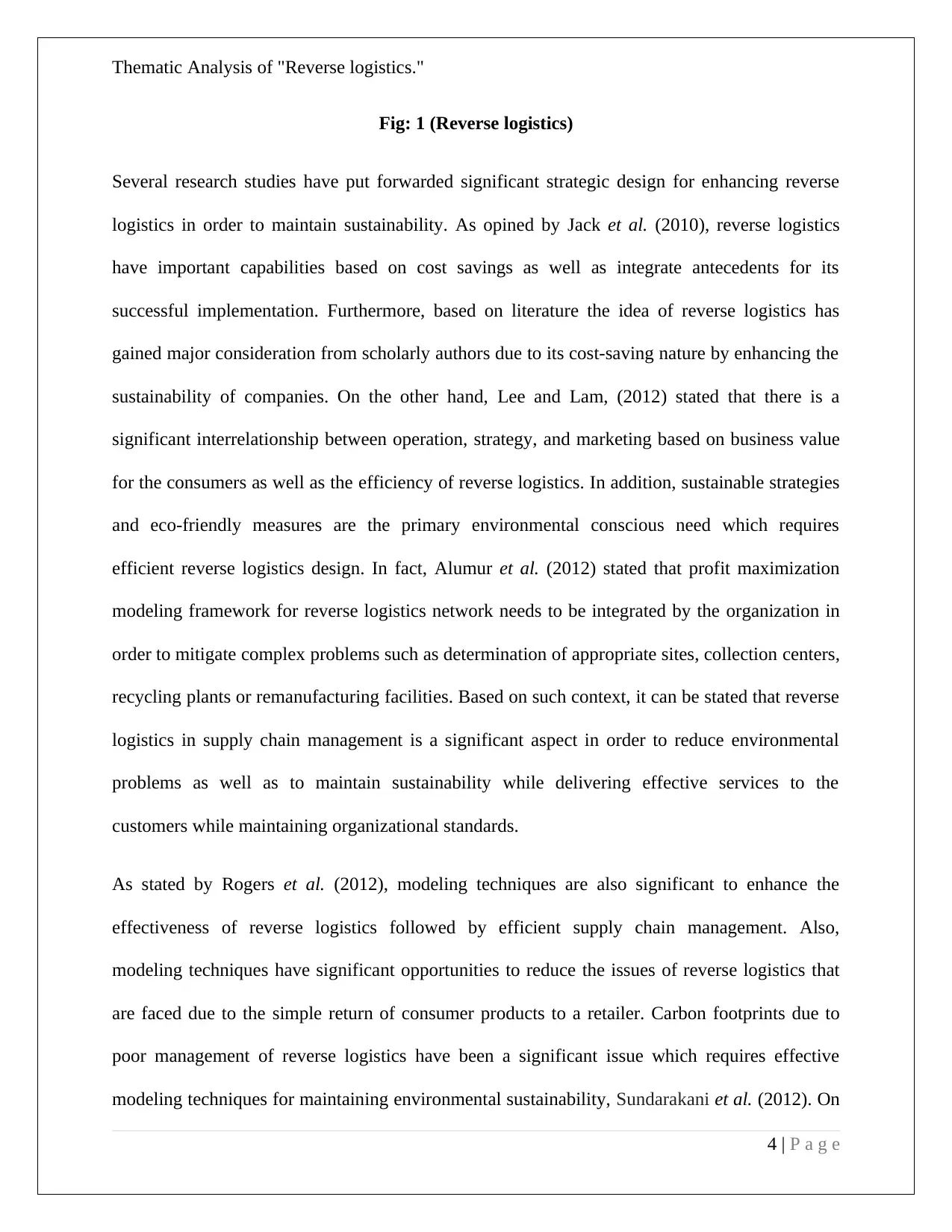
Thematic Analysis of "Reverse logistics."
Fig: 1 (Reverse logistics)
Several research studies have put forwarded significant strategic design for enhancing reverse
logistics in order to maintain sustainability. As opined by Jack et al. (2010), reverse logistics
have important capabilities based on cost savings as well as integrate antecedents for its
successful implementation. Furthermore, based on literature the idea of reverse logistics has
gained major consideration from scholarly authors due to its cost-saving nature by enhancing the
sustainability of companies. On the other hand, Lee and Lam, (2012) stated that there is a
significant interrelationship between operation, strategy, and marketing based on business value
for the consumers as well as the efficiency of reverse logistics. In addition, sustainable strategies
and eco-friendly measures are the primary environmental conscious need which requires
efficient reverse logistics design. In fact, Alumur et al. (2012) stated that profit maximization
modeling framework for reverse logistics network needs to be integrated by the organization in
order to mitigate complex problems such as determination of appropriate sites, collection centers,
recycling plants or remanufacturing facilities. Based on such context, it can be stated that reverse
logistics in supply chain management is a significant aspect in order to reduce environmental
problems as well as to maintain sustainability while delivering effective services to the
customers while maintaining organizational standards.
As stated by Rogers et al. (2012), modeling techniques are also significant to enhance the
effectiveness of reverse logistics followed by efficient supply chain management. Also,
modeling techniques have significant opportunities to reduce the issues of reverse logistics that
are faced due to the simple return of consumer products to a retailer. Carbon footprints due to
poor management of reverse logistics have been a significant issue which requires effective
modeling techniques for maintaining environmental sustainability, Sundarakani et al. (2012). On
4 | P a g e
Fig: 1 (Reverse logistics)
Several research studies have put forwarded significant strategic design for enhancing reverse
logistics in order to maintain sustainability. As opined by Jack et al. (2010), reverse logistics
have important capabilities based on cost savings as well as integrate antecedents for its
successful implementation. Furthermore, based on literature the idea of reverse logistics has
gained major consideration from scholarly authors due to its cost-saving nature by enhancing the
sustainability of companies. On the other hand, Lee and Lam, (2012) stated that there is a
significant interrelationship between operation, strategy, and marketing based on business value
for the consumers as well as the efficiency of reverse logistics. In addition, sustainable strategies
and eco-friendly measures are the primary environmental conscious need which requires
efficient reverse logistics design. In fact, Alumur et al. (2012) stated that profit maximization
modeling framework for reverse logistics network needs to be integrated by the organization in
order to mitigate complex problems such as determination of appropriate sites, collection centers,
recycling plants or remanufacturing facilities. Based on such context, it can be stated that reverse
logistics in supply chain management is a significant aspect in order to reduce environmental
problems as well as to maintain sustainability while delivering effective services to the
customers while maintaining organizational standards.
As stated by Rogers et al. (2012), modeling techniques are also significant to enhance the
effectiveness of reverse logistics followed by efficient supply chain management. Also,
modeling techniques have significant opportunities to reduce the issues of reverse logistics that
are faced due to the simple return of consumer products to a retailer. Carbon footprints due to
poor management of reverse logistics have been a significant issue which requires effective
modeling techniques for maintaining environmental sustainability, Sundarakani et al. (2012). On
4 | P a g e
Paraphrase This Document
Need a fresh take? Get an instant paraphrase of this document with our AI Paraphraser
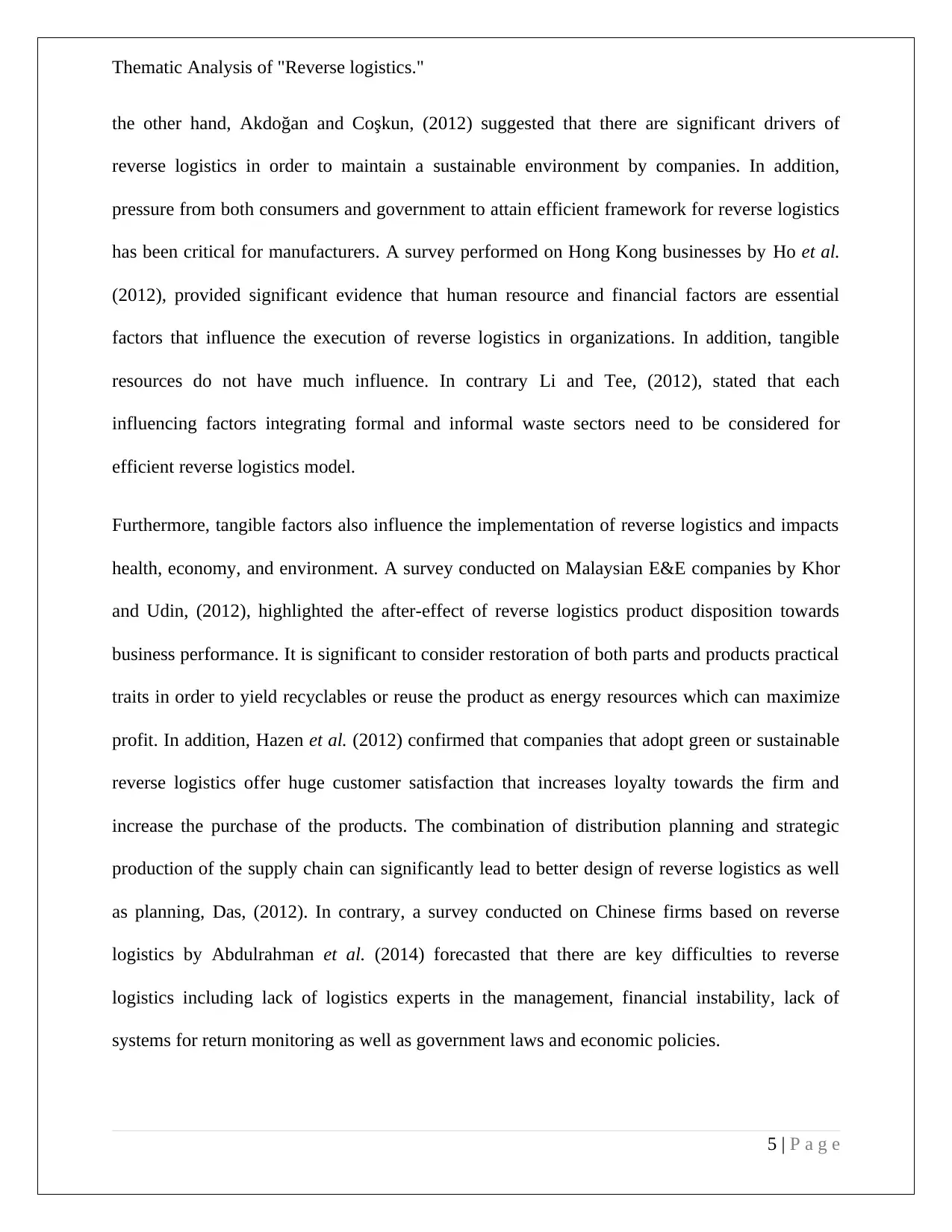
Thematic Analysis of "Reverse logistics."
the other hand, Akdoğan and Coşkun, (2012) suggested that there are significant drivers of
reverse logistics in order to maintain a sustainable environment by companies. In addition,
pressure from both consumers and government to attain efficient framework for reverse logistics
has been critical for manufacturers. A survey performed on Hong Kong businesses by Ho et al.
(2012), provided significant evidence that human resource and financial factors are essential
factors that influence the execution of reverse logistics in organizations. In addition, tangible
resources do not have much influence. In contrary Li and Tee, (2012), stated that each
influencing factors integrating formal and informal waste sectors need to be considered for
efficient reverse logistics model.
Furthermore, tangible factors also influence the implementation of reverse logistics and impacts
health, economy, and environment. A survey conducted on Malaysian E&E companies by Khor
and Udin, (2012), highlighted the after-effect of reverse logistics product disposition towards
business performance. It is significant to consider restoration of both parts and products practical
traits in order to yield recyclables or reuse the product as energy resources which can maximize
profit. In addition, Hazen et al. (2012) confirmed that companies that adopt green or sustainable
reverse logistics offer huge customer satisfaction that increases loyalty towards the firm and
increase the purchase of the products. The combination of distribution planning and strategic
production of the supply chain can significantly lead to better design of reverse logistics as well
as planning, Das, (2012). In contrary, a survey conducted on Chinese firms based on reverse
logistics by Abdulrahman et al. (2014) forecasted that there are key difficulties to reverse
logistics including lack of logistics experts in the management, financial instability, lack of
systems for return monitoring as well as government laws and economic policies.
5 | P a g e
the other hand, Akdoğan and Coşkun, (2012) suggested that there are significant drivers of
reverse logistics in order to maintain a sustainable environment by companies. In addition,
pressure from both consumers and government to attain efficient framework for reverse logistics
has been critical for manufacturers. A survey performed on Hong Kong businesses by Ho et al.
(2012), provided significant evidence that human resource and financial factors are essential
factors that influence the execution of reverse logistics in organizations. In addition, tangible
resources do not have much influence. In contrary Li and Tee, (2012), stated that each
influencing factors integrating formal and informal waste sectors need to be considered for
efficient reverse logistics model.
Furthermore, tangible factors also influence the implementation of reverse logistics and impacts
health, economy, and environment. A survey conducted on Malaysian E&E companies by Khor
and Udin, (2012), highlighted the after-effect of reverse logistics product disposition towards
business performance. It is significant to consider restoration of both parts and products practical
traits in order to yield recyclables or reuse the product as energy resources which can maximize
profit. In addition, Hazen et al. (2012) confirmed that companies that adopt green or sustainable
reverse logistics offer huge customer satisfaction that increases loyalty towards the firm and
increase the purchase of the products. The combination of distribution planning and strategic
production of the supply chain can significantly lead to better design of reverse logistics as well
as planning, Das, (2012). In contrary, a survey conducted on Chinese firms based on reverse
logistics by Abdulrahman et al. (2014) forecasted that there are key difficulties to reverse
logistics including lack of logistics experts in the management, financial instability, lack of
systems for return monitoring as well as government laws and economic policies.
5 | P a g e
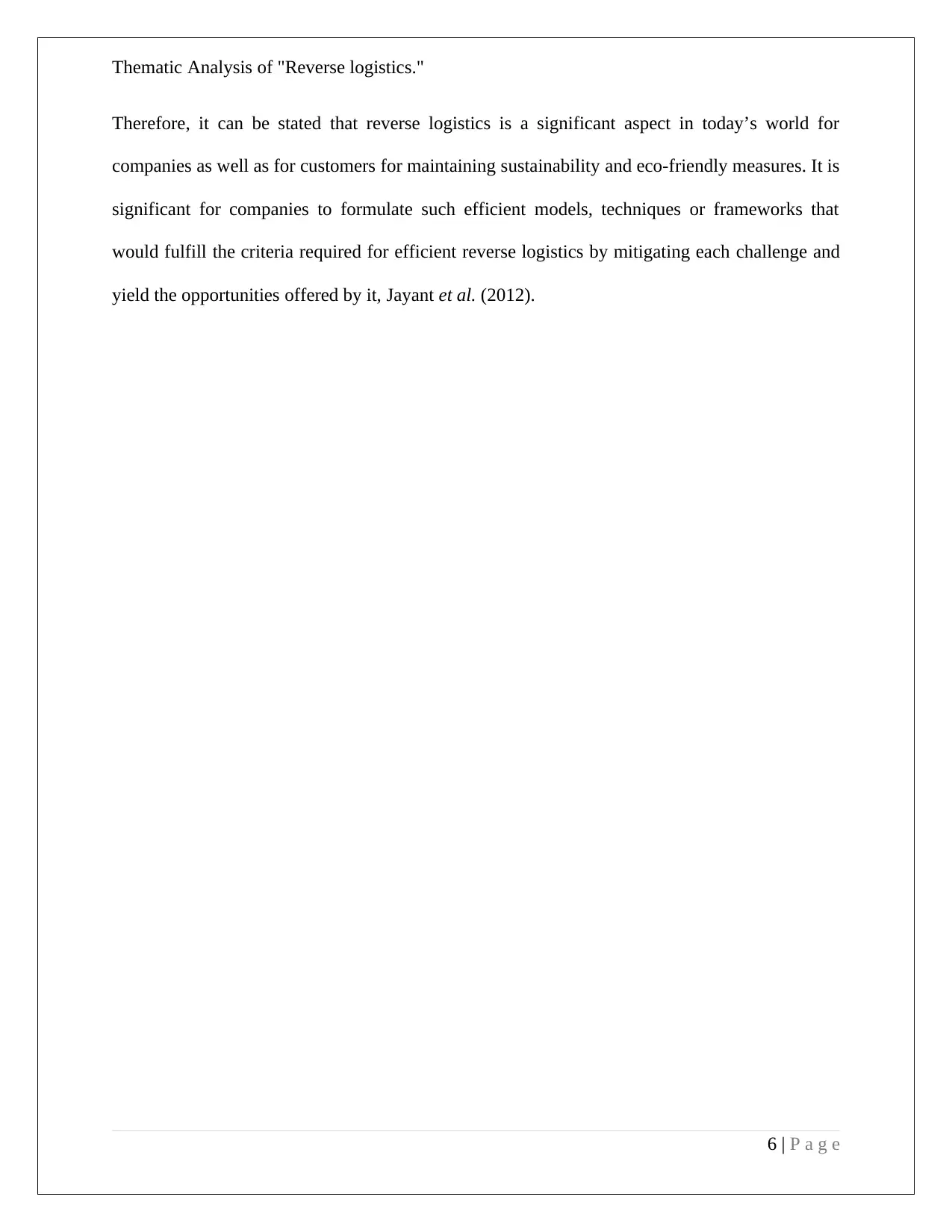
Thematic Analysis of "Reverse logistics."
Therefore, it can be stated that reverse logistics is a significant aspect in today’s world for
companies as well as for customers for maintaining sustainability and eco-friendly measures. It is
significant for companies to formulate such efficient models, techniques or frameworks that
would fulfill the criteria required for efficient reverse logistics by mitigating each challenge and
yield the opportunities offered by it, Jayant et al. (2012).
6 | P a g e
Therefore, it can be stated that reverse logistics is a significant aspect in today’s world for
companies as well as for customers for maintaining sustainability and eco-friendly measures. It is
significant for companies to formulate such efficient models, techniques or frameworks that
would fulfill the criteria required for efficient reverse logistics by mitigating each challenge and
yield the opportunities offered by it, Jayant et al. (2012).
6 | P a g e
⊘ This is a preview!⊘
Do you want full access?
Subscribe today to unlock all pages.

Trusted by 1+ million students worldwide
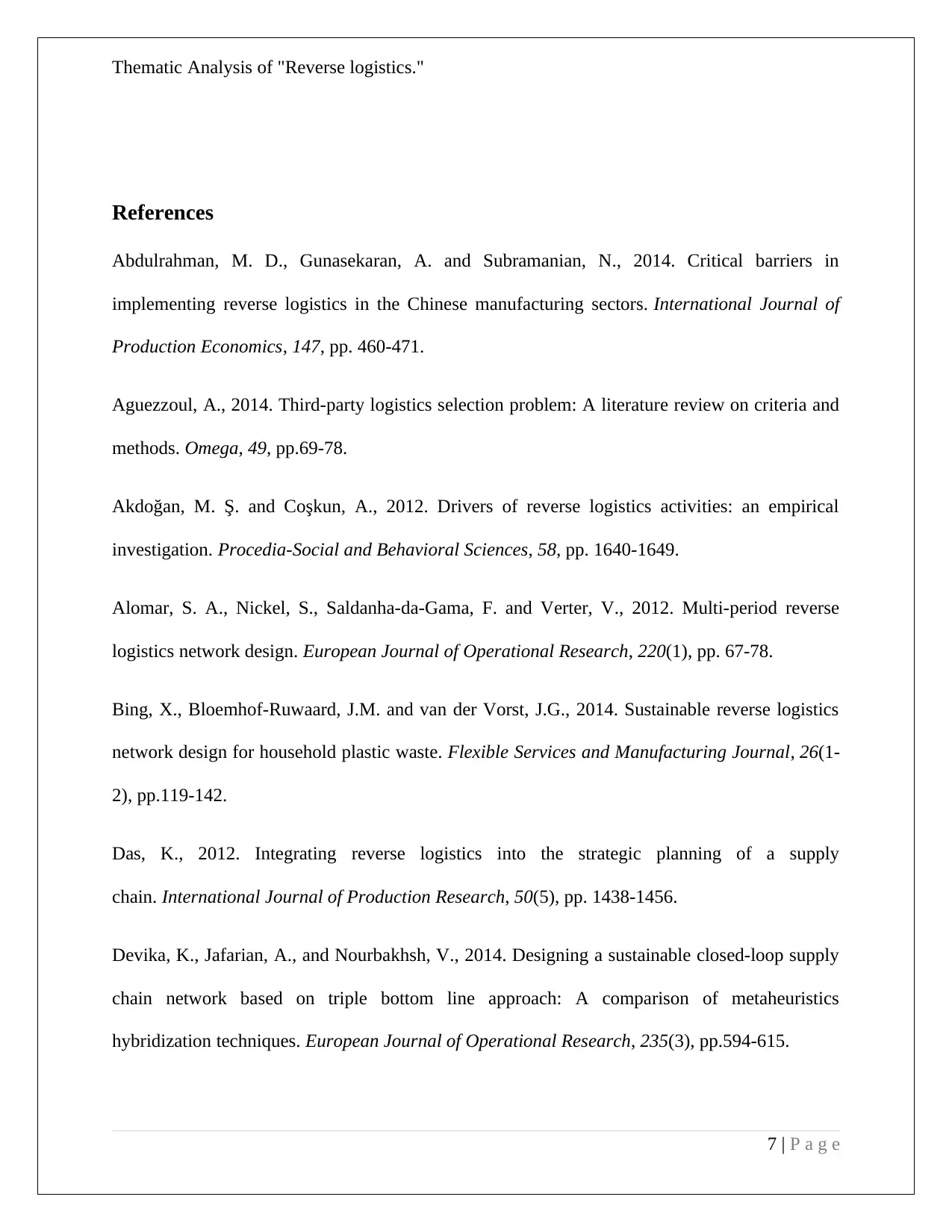
Thematic Analysis of "Reverse logistics."
References
Abdulrahman, M. D., Gunasekaran, A. and Subramanian, N., 2014. Critical barriers in
implementing reverse logistics in the Chinese manufacturing sectors. International Journal of
Production Economics, 147, pp. 460-471.
Aguezzoul, A., 2014. Third-party logistics selection problem: A literature review on criteria and
methods. Omega, 49, pp.69-78.
Akdoğan, M. Ş. and Coşkun, A., 2012. Drivers of reverse logistics activities: an empirical
investigation. Procedia-Social and Behavioral Sciences, 58, pp. 1640-1649.
Alomar, S. A., Nickel, S., Saldanha-da-Gama, F. and Verter, V., 2012. Multi-period reverse
logistics network design. European Journal of Operational Research, 220(1), pp. 67-78.
Bing, X., Bloemhof-Ruwaard, J.M. and van der Vorst, J.G., 2014. Sustainable reverse logistics
network design for household plastic waste. Flexible Services and Manufacturing Journal, 26(1-
2), pp.119-142.
Das, K., 2012. Integrating reverse logistics into the strategic planning of a supply
chain. International Journal of Production Research, 50(5), pp. 1438-1456.
Devika, K., Jafarian, A., and Nourbakhsh, V., 2014. Designing a sustainable closed-loop supply
chain network based on triple bottom line approach: A comparison of metaheuristics
hybridization techniques. European Journal of Operational Research, 235(3), pp.594-615.
7 | P a g e
References
Abdulrahman, M. D., Gunasekaran, A. and Subramanian, N., 2014. Critical barriers in
implementing reverse logistics in the Chinese manufacturing sectors. International Journal of
Production Economics, 147, pp. 460-471.
Aguezzoul, A., 2014. Third-party logistics selection problem: A literature review on criteria and
methods. Omega, 49, pp.69-78.
Akdoğan, M. Ş. and Coşkun, A., 2012. Drivers of reverse logistics activities: an empirical
investigation. Procedia-Social and Behavioral Sciences, 58, pp. 1640-1649.
Alomar, S. A., Nickel, S., Saldanha-da-Gama, F. and Verter, V., 2012. Multi-period reverse
logistics network design. European Journal of Operational Research, 220(1), pp. 67-78.
Bing, X., Bloemhof-Ruwaard, J.M. and van der Vorst, J.G., 2014. Sustainable reverse logistics
network design for household plastic waste. Flexible Services and Manufacturing Journal, 26(1-
2), pp.119-142.
Das, K., 2012. Integrating reverse logistics into the strategic planning of a supply
chain. International Journal of Production Research, 50(5), pp. 1438-1456.
Devika, K., Jafarian, A., and Nourbakhsh, V., 2014. Designing a sustainable closed-loop supply
chain network based on triple bottom line approach: A comparison of metaheuristics
hybridization techniques. European Journal of Operational Research, 235(3), pp.594-615.
7 | P a g e
Paraphrase This Document
Need a fresh take? Get an instant paraphrase of this document with our AI Paraphraser
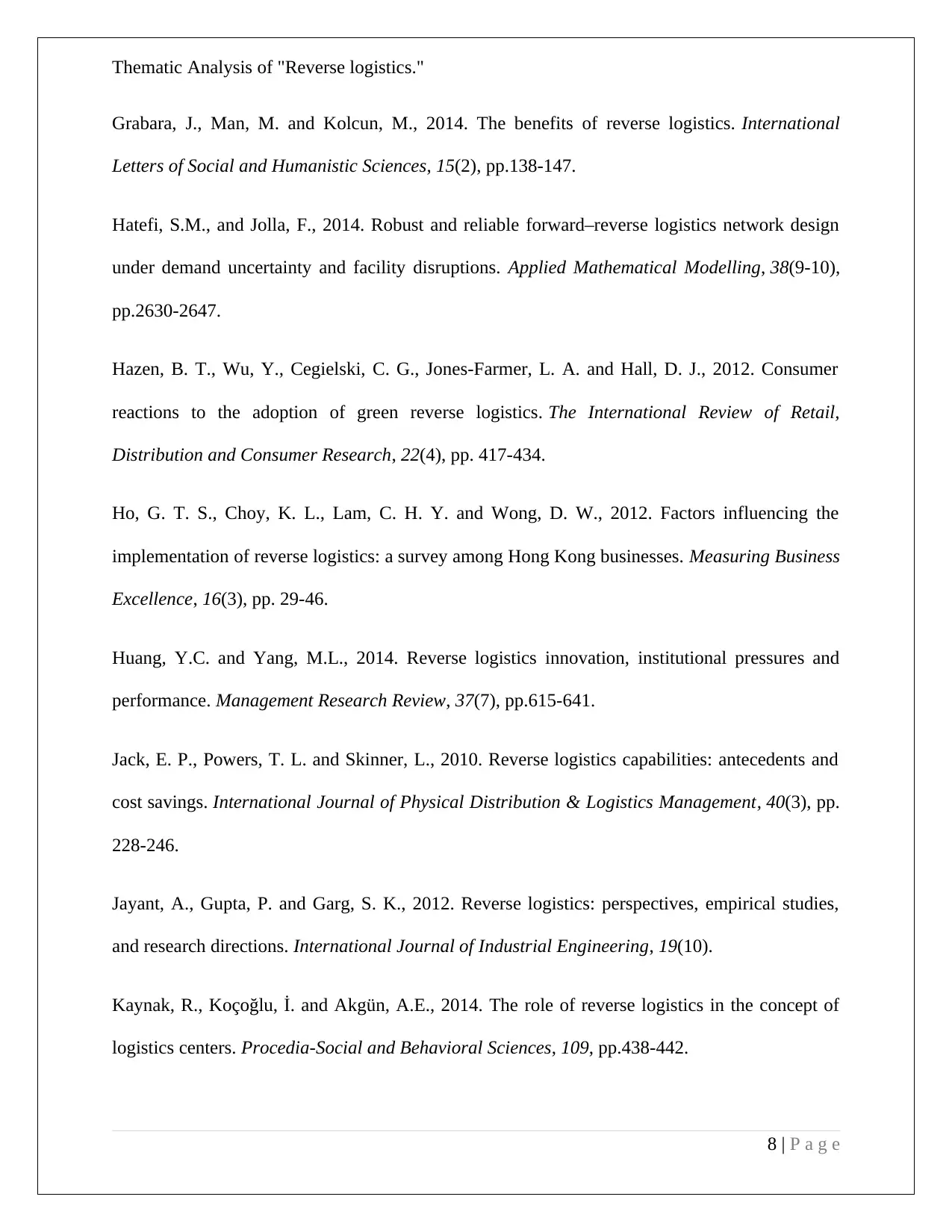
Thematic Analysis of "Reverse logistics."
Grabara, J., Man, M. and Kolcun, M., 2014. The benefits of reverse logistics. International
Letters of Social and Humanistic Sciences, 15(2), pp.138-147.
Hatefi, S.M., and Jolla, F., 2014. Robust and reliable forward–reverse logistics network design
under demand uncertainty and facility disruptions. Applied Mathematical Modelling, 38(9-10),
pp.2630-2647.
Hazen, B. T., Wu, Y., Cegielski, C. G., Jones-Farmer, L. A. and Hall, D. J., 2012. Consumer
reactions to the adoption of green reverse logistics. The International Review of Retail,
Distribution and Consumer Research, 22(4), pp. 417-434.
Ho, G. T. S., Choy, K. L., Lam, C. H. Y. and Wong, D. W., 2012. Factors influencing the
implementation of reverse logistics: a survey among Hong Kong businesses. Measuring Business
Excellence, 16(3), pp. 29-46.
Huang, Y.C. and Yang, M.L., 2014. Reverse logistics innovation, institutional pressures and
performance. Management Research Review, 37(7), pp.615-641.
Jack, E. P., Powers, T. L. and Skinner, L., 2010. Reverse logistics capabilities: antecedents and
cost savings. International Journal of Physical Distribution & Logistics Management, 40(3), pp.
228-246.
Jayant, A., Gupta, P. and Garg, S. K., 2012. Reverse logistics: perspectives, empirical studies,
and research directions. International Journal of Industrial Engineering, 19(10).
Kaynak, R., Koçoğlu, İ. and Akgün, A.E., 2014. The role of reverse logistics in the concept of
logistics centers. Procedia-Social and Behavioral Sciences, 109, pp.438-442.
8 | P a g e
Grabara, J., Man, M. and Kolcun, M., 2014. The benefits of reverse logistics. International
Letters of Social and Humanistic Sciences, 15(2), pp.138-147.
Hatefi, S.M., and Jolla, F., 2014. Robust and reliable forward–reverse logistics network design
under demand uncertainty and facility disruptions. Applied Mathematical Modelling, 38(9-10),
pp.2630-2647.
Hazen, B. T., Wu, Y., Cegielski, C. G., Jones-Farmer, L. A. and Hall, D. J., 2012. Consumer
reactions to the adoption of green reverse logistics. The International Review of Retail,
Distribution and Consumer Research, 22(4), pp. 417-434.
Ho, G. T. S., Choy, K. L., Lam, C. H. Y. and Wong, D. W., 2012. Factors influencing the
implementation of reverse logistics: a survey among Hong Kong businesses. Measuring Business
Excellence, 16(3), pp. 29-46.
Huang, Y.C. and Yang, M.L., 2014. Reverse logistics innovation, institutional pressures and
performance. Management Research Review, 37(7), pp.615-641.
Jack, E. P., Powers, T. L. and Skinner, L., 2010. Reverse logistics capabilities: antecedents and
cost savings. International Journal of Physical Distribution & Logistics Management, 40(3), pp.
228-246.
Jayant, A., Gupta, P. and Garg, S. K., 2012. Reverse logistics: perspectives, empirical studies,
and research directions. International Journal of Industrial Engineering, 19(10).
Kaynak, R., Koçoğlu, İ. and Akgün, A.E., 2014. The role of reverse logistics in the concept of
logistics centers. Procedia-Social and Behavioral Sciences, 109, pp.438-442.
8 | P a g e
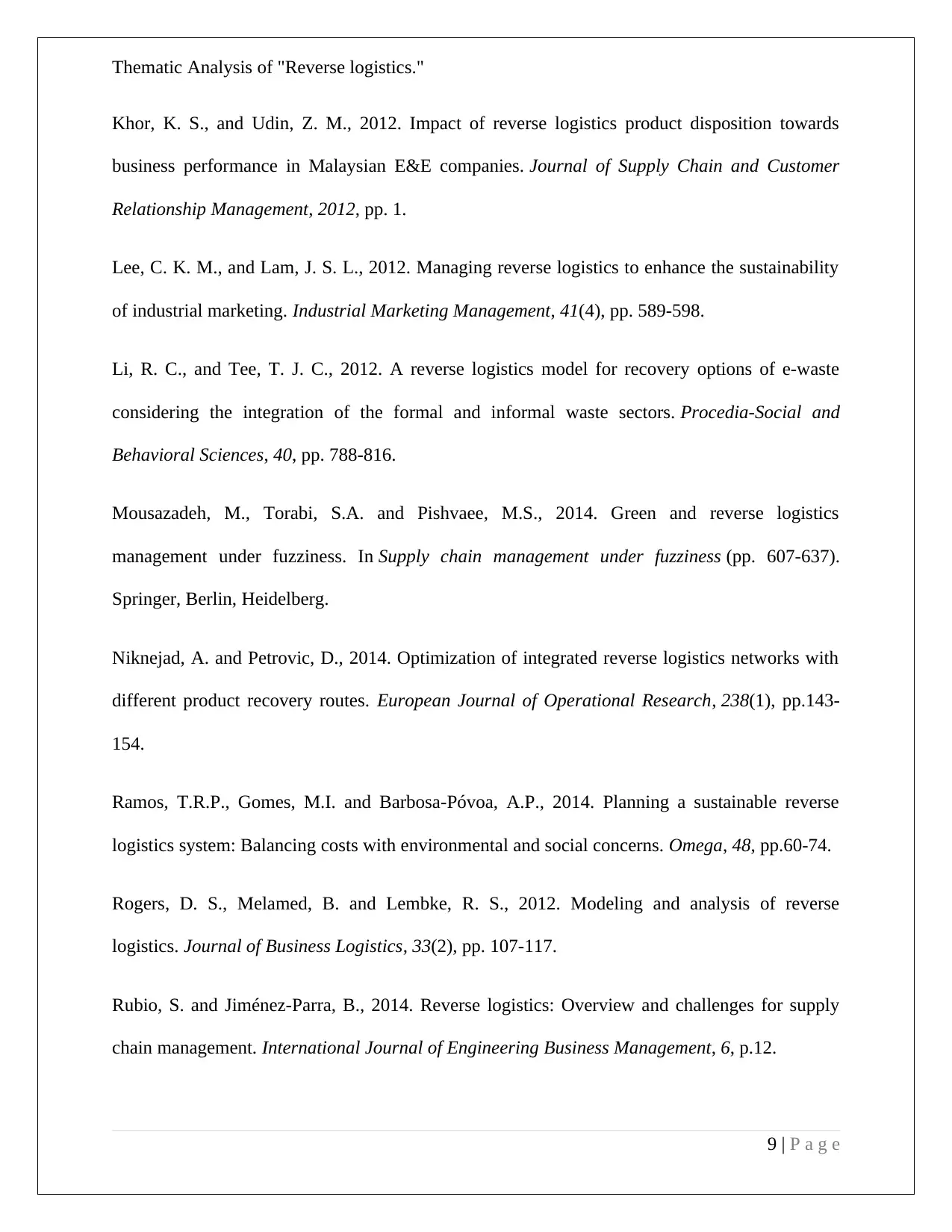
Thematic Analysis of "Reverse logistics."
Khor, K. S., and Udin, Z. M., 2012. Impact of reverse logistics product disposition towards
business performance in Malaysian E&E companies. Journal of Supply Chain and Customer
Relationship Management, 2012, pp. 1.
Lee, C. K. M., and Lam, J. S. L., 2012. Managing reverse logistics to enhance the sustainability
of industrial marketing. Industrial Marketing Management, 41(4), pp. 589-598.
Li, R. C., and Tee, T. J. C., 2012. A reverse logistics model for recovery options of e-waste
considering the integration of the formal and informal waste sectors. Procedia-Social and
Behavioral Sciences, 40, pp. 788-816.
Mousazadeh, M., Torabi, S.A. and Pishvaee, M.S., 2014. Green and reverse logistics
management under fuzziness. In Supply chain management under fuzziness (pp. 607-637).
Springer, Berlin, Heidelberg.
Niknejad, A. and Petrovic, D., 2014. Optimization of integrated reverse logistics networks with
different product recovery routes. European Journal of Operational Research, 238(1), pp.143-
154.
Ramos, T.R.P., Gomes, M.I. and Barbosa-Póvoa, A.P., 2014. Planning a sustainable reverse
logistics system: Balancing costs with environmental and social concerns. Omega, 48, pp.60-74.
Rogers, D. S., Melamed, B. and Lembke, R. S., 2012. Modeling and analysis of reverse
logistics. Journal of Business Logistics, 33(2), pp. 107-117.
Rubio, S. and Jiménez-Parra, B., 2014. Reverse logistics: Overview and challenges for supply
chain management. International Journal of Engineering Business Management, 6, p.12.
9 | P a g e
Khor, K. S., and Udin, Z. M., 2012. Impact of reverse logistics product disposition towards
business performance in Malaysian E&E companies. Journal of Supply Chain and Customer
Relationship Management, 2012, pp. 1.
Lee, C. K. M., and Lam, J. S. L., 2012. Managing reverse logistics to enhance the sustainability
of industrial marketing. Industrial Marketing Management, 41(4), pp. 589-598.
Li, R. C., and Tee, T. J. C., 2012. A reverse logistics model for recovery options of e-waste
considering the integration of the formal and informal waste sectors. Procedia-Social and
Behavioral Sciences, 40, pp. 788-816.
Mousazadeh, M., Torabi, S.A. and Pishvaee, M.S., 2014. Green and reverse logistics
management under fuzziness. In Supply chain management under fuzziness (pp. 607-637).
Springer, Berlin, Heidelberg.
Niknejad, A. and Petrovic, D., 2014. Optimization of integrated reverse logistics networks with
different product recovery routes. European Journal of Operational Research, 238(1), pp.143-
154.
Ramos, T.R.P., Gomes, M.I. and Barbosa-Póvoa, A.P., 2014. Planning a sustainable reverse
logistics system: Balancing costs with environmental and social concerns. Omega, 48, pp.60-74.
Rogers, D. S., Melamed, B. and Lembke, R. S., 2012. Modeling and analysis of reverse
logistics. Journal of Business Logistics, 33(2), pp. 107-117.
Rubio, S. and Jiménez-Parra, B., 2014. Reverse logistics: Overview and challenges for supply
chain management. International Journal of Engineering Business Management, 6, p.12.
9 | P a g e
⊘ This is a preview!⊘
Do you want full access?
Subscribe today to unlock all pages.

Trusted by 1+ million students worldwide
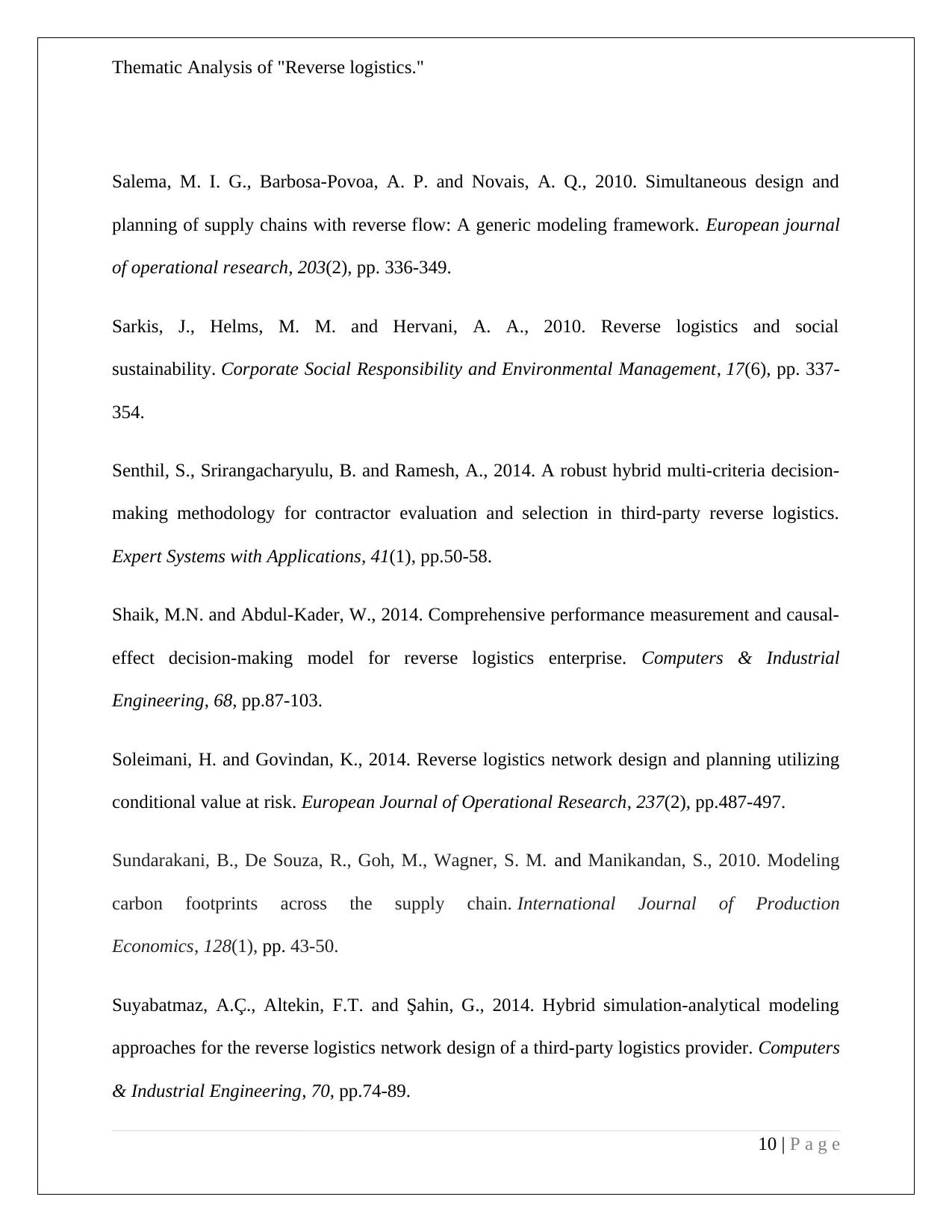
Thematic Analysis of "Reverse logistics."
Salema, M. I. G., Barbosa-Povoa, A. P. and Novais, A. Q., 2010. Simultaneous design and
planning of supply chains with reverse flow: A generic modeling framework. European journal
of operational research, 203(2), pp. 336-349.
Sarkis, J., Helms, M. M. and Hervani, A. A., 2010. Reverse logistics and social
sustainability. Corporate Social Responsibility and Environmental Management, 17(6), pp. 337-
354.
Senthil, S., Srirangacharyulu, B. and Ramesh, A., 2014. A robust hybrid multi-criteria decision-
making methodology for contractor evaluation and selection in third-party reverse logistics.
Expert Systems with Applications, 41(1), pp.50-58.
Shaik, M.N. and Abdul-Kader, W., 2014. Comprehensive performance measurement and causal-
effect decision-making model for reverse logistics enterprise. Computers & Industrial
Engineering, 68, pp.87-103.
Soleimani, H. and Govindan, K., 2014. Reverse logistics network design and planning utilizing
conditional value at risk. European Journal of Operational Research, 237(2), pp.487-497.
Sundarakani, B., De Souza, R., Goh, M., Wagner, S. M. and Manikandan, S., 2010. Modeling
carbon footprints across the supply chain. International Journal of Production
Economics, 128(1), pp. 43-50.
Suyabatmaz, A.Ç., Altekin, F.T. and Şahin, G., 2014. Hybrid simulation-analytical modeling
approaches for the reverse logistics network design of a third-party logistics provider. Computers
& Industrial Engineering, 70, pp.74-89.
10 | P a g e
Salema, M. I. G., Barbosa-Povoa, A. P. and Novais, A. Q., 2010. Simultaneous design and
planning of supply chains with reverse flow: A generic modeling framework. European journal
of operational research, 203(2), pp. 336-349.
Sarkis, J., Helms, M. M. and Hervani, A. A., 2010. Reverse logistics and social
sustainability. Corporate Social Responsibility and Environmental Management, 17(6), pp. 337-
354.
Senthil, S., Srirangacharyulu, B. and Ramesh, A., 2014. A robust hybrid multi-criteria decision-
making methodology for contractor evaluation and selection in third-party reverse logistics.
Expert Systems with Applications, 41(1), pp.50-58.
Shaik, M.N. and Abdul-Kader, W., 2014. Comprehensive performance measurement and causal-
effect decision-making model for reverse logistics enterprise. Computers & Industrial
Engineering, 68, pp.87-103.
Soleimani, H. and Govindan, K., 2014. Reverse logistics network design and planning utilizing
conditional value at risk. European Journal of Operational Research, 237(2), pp.487-497.
Sundarakani, B., De Souza, R., Goh, M., Wagner, S. M. and Manikandan, S., 2010. Modeling
carbon footprints across the supply chain. International Journal of Production
Economics, 128(1), pp. 43-50.
Suyabatmaz, A.Ç., Altekin, F.T. and Şahin, G., 2014. Hybrid simulation-analytical modeling
approaches for the reverse logistics network design of a third-party logistics provider. Computers
& Industrial Engineering, 70, pp.74-89.
10 | P a g e
Paraphrase This Document
Need a fresh take? Get an instant paraphrase of this document with our AI Paraphraser
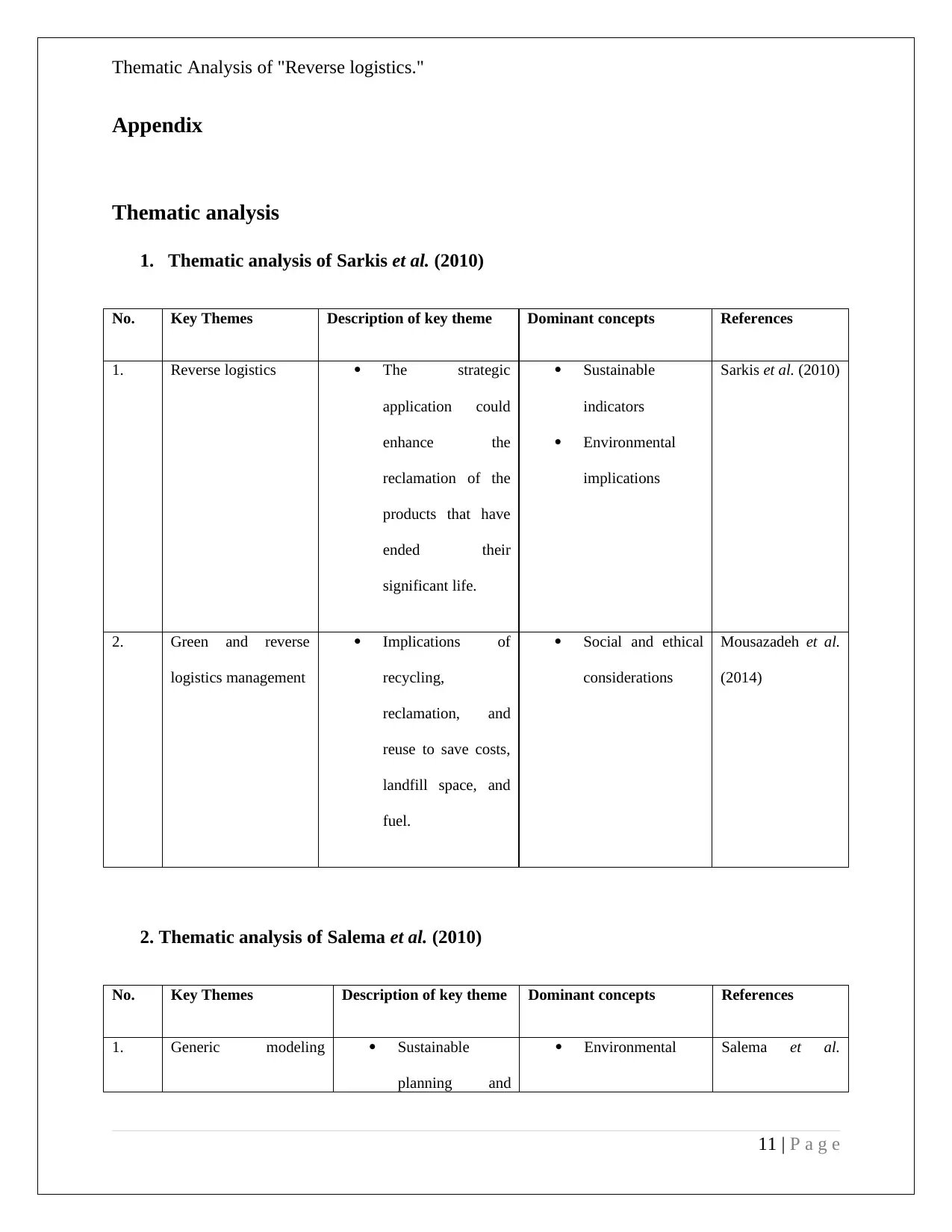
Thematic Analysis of "Reverse logistics."
Appendix
Thematic analysis
1. Thematic analysis of Sarkis et al. (2010)
No. Key Themes Description of key theme Dominant concepts References
1. Reverse logistics The strategic
application could
enhance the
reclamation of the
products that have
ended their
significant life.
Sustainable
indicators
Environmental
implications
Sarkis et al. (2010)
2. Green and reverse
logistics management
Implications of
recycling,
reclamation, and
reuse to save costs,
landfill space, and
fuel.
Social and ethical
considerations
Mousazadeh et al.
(2014)
2. Thematic analysis of Salema et al. (2010)
No. Key Themes Description of key theme Dominant concepts References
1. Generic modeling Sustainable
planning and
Environmental Salema et al.
11 | P a g e
Appendix
Thematic analysis
1. Thematic analysis of Sarkis et al. (2010)
No. Key Themes Description of key theme Dominant concepts References
1. Reverse logistics The strategic
application could
enhance the
reclamation of the
products that have
ended their
significant life.
Sustainable
indicators
Environmental
implications
Sarkis et al. (2010)
2. Green and reverse
logistics management
Implications of
recycling,
reclamation, and
reuse to save costs,
landfill space, and
fuel.
Social and ethical
considerations
Mousazadeh et al.
(2014)
2. Thematic analysis of Salema et al. (2010)
No. Key Themes Description of key theme Dominant concepts References
1. Generic modeling Sustainable
planning and
Environmental Salema et al.
11 | P a g e
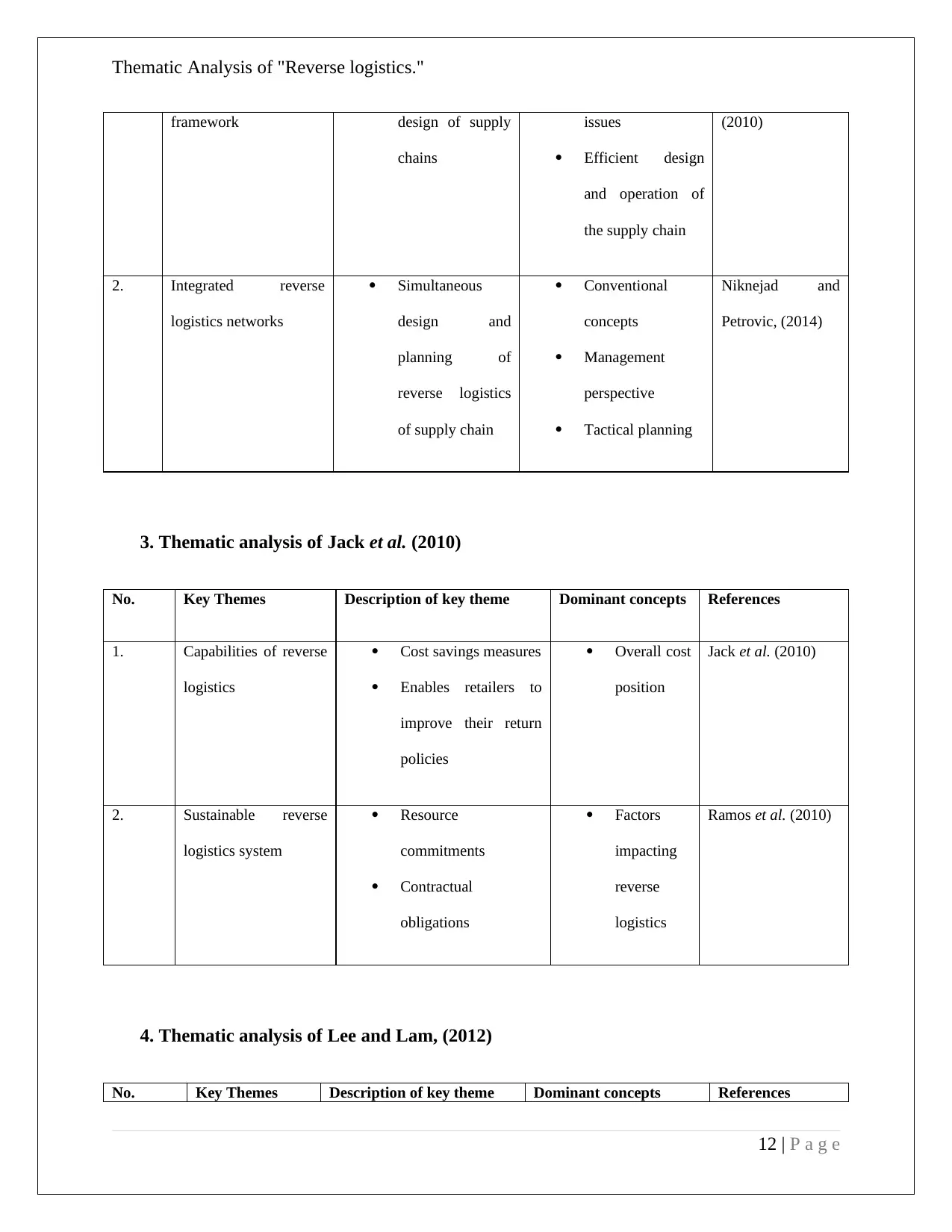
Thematic Analysis of "Reverse logistics."
framework design of supply
chains
issues
Efficient design
and operation of
the supply chain
(2010)
2. Integrated reverse
logistics networks
Simultaneous
design and
planning of
reverse logistics
of supply chain
Conventional
concepts
Management
perspective
Tactical planning
Niknejad and
Petrovic, (2014)
3. Thematic analysis of Jack et al. (2010)
No. Key Themes Description of key theme Dominant concepts References
1. Capabilities of reverse
logistics
Cost savings measures
Enables retailers to
improve their return
policies
Overall cost
position
Jack et al. (2010)
2. Sustainable reverse
logistics system
Resource
commitments
Contractual
obligations
Factors
impacting
reverse
logistics
Ramos et al. (2010)
4. Thematic analysis of Lee and Lam, (2012)
No. Key Themes Description of key theme Dominant concepts References
12 | P a g e
framework design of supply
chains
issues
Efficient design
and operation of
the supply chain
(2010)
2. Integrated reverse
logistics networks
Simultaneous
design and
planning of
reverse logistics
of supply chain
Conventional
concepts
Management
perspective
Tactical planning
Niknejad and
Petrovic, (2014)
3. Thematic analysis of Jack et al. (2010)
No. Key Themes Description of key theme Dominant concepts References
1. Capabilities of reverse
logistics
Cost savings measures
Enables retailers to
improve their return
policies
Overall cost
position
Jack et al. (2010)
2. Sustainable reverse
logistics system
Resource
commitments
Contractual
obligations
Factors
impacting
reverse
logistics
Ramos et al. (2010)
4. Thematic analysis of Lee and Lam, (2012)
No. Key Themes Description of key theme Dominant concepts References
12 | P a g e
⊘ This is a preview!⊘
Do you want full access?
Subscribe today to unlock all pages.

Trusted by 1+ million students worldwide
1 out of 26
Related Documents
Your All-in-One AI-Powered Toolkit for Academic Success.
+13062052269
info@desklib.com
Available 24*7 on WhatsApp / Email
![[object Object]](/_next/static/media/star-bottom.7253800d.svg)
Unlock your academic potential
Copyright © 2020–2025 A2Z Services. All Rights Reserved. Developed and managed by ZUCOL.




